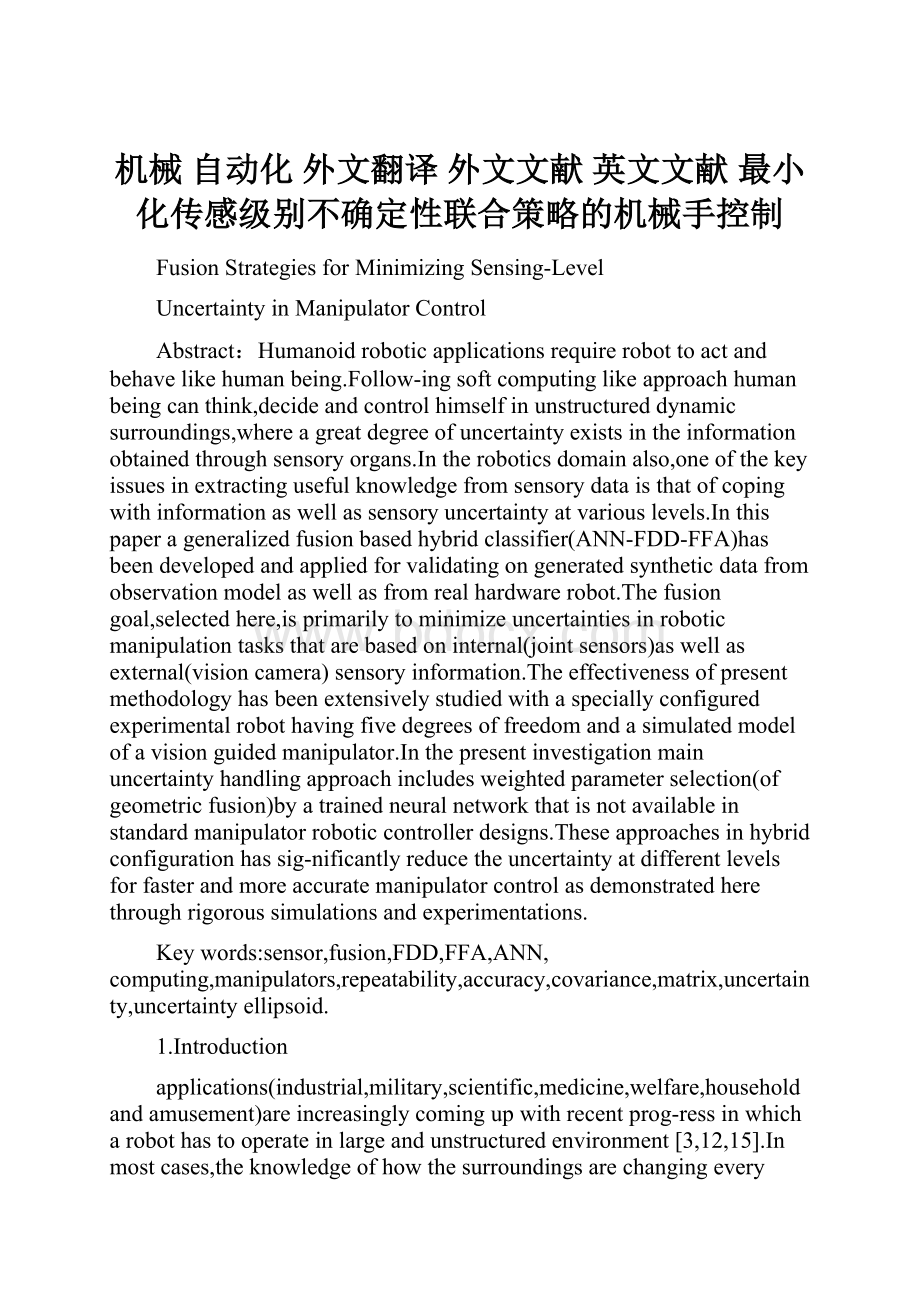机械 自动化 外文翻译 外文文献 英文文献 最小化传感级别不确定性联合策略的机械手控制.docx
《机械 自动化 外文翻译 外文文献 英文文献 最小化传感级别不确定性联合策略的机械手控制.docx》由会员分享,可在线阅读,更多相关《机械 自动化 外文翻译 外文文献 英文文献 最小化传感级别不确定性联合策略的机械手控制.docx(14页珍藏版)》请在冰豆网上搜索。

机械自动化外文翻译外文文献英文文献最小化传感级别不确定性联合策略的机械手控制
FusionStrategiesforMinimizingSensing-Level
UncertaintyinManipulatorControl
Abstract:
Humanoidroboticapplicationsrequirerobottoactandbehavelikehumanbeing.Follow-ingsoftcomputinglikeapproachhumanbeingcanthink,decideandcontrolhimselfinunstructureddynamicsurroundings,whereagreatdegreeofuncertaintyexistsintheinformationobtainedthroughsensoryorgans.Intheroboticsdomainalso,oneofthekeyissuesinextractingusefulknowledgefromsensorydataisthatofcopingwithinformationaswellassensoryuncertaintyatvariouslevels.Inthispaperageneralizedfusionbasedhybridclassifier(ANN-FDD-FFA)hasbeendevelopedandappliedforvalidatingongeneratedsyntheticdatafromobservationmodelaswellasfromrealhardwarerobot.Thefusiongoal,selectedhere,isprimarilytominimizeuncertaintiesinroboticmanipulationtasksthatarebasedoninternal(jointsensors)aswellasexternal(visioncamera)sensoryinformation.Theeffectivenessofpresentmethodologyhasbeenextensivelystudiedwithaspeciallyconfiguredexperimentalrobothavingfivedegreesoffreedomandasimulatedmodelofavisionguidedmanipulator.Inthepresentinvestigationmainuncertaintyhandlingapproachincludesweightedparameterselection(ofgeometricfusion)byatrainedneuralnetworkthatisnotavailableinstandardmanipulatorroboticcontrollerdesigns.Theseapproachesinhybridconfigurationhassig-nificantlyreducetheuncertaintyatdifferentlevelsforfasterandmoreaccuratemanipulatorcontrolasdemonstratedherethroughrigoroussimulationsandexperimentations.
Keywords:
sensor,fusion,FDD,FFA,ANN,computing,manipulators,repeatability,accuracy,covariance,matrix,uncertainty,uncertaintyellipsoid.
1.Introduction
applications(industrial,military,scientific,medicine,welfare,householdandamusement)areincreasinglycomingupwithrecentprog-ressinwhicharobothastooperateinlargeandunstructuredenvironment[3,12,15].Inmostcases,theknowledgeofhowthesurroundingsarechangingeveryinstantisfundamentallyimportantforanoptimalcontrolofrobotmotions.Mobilerobotsalsoessentiallyhavetonavigateandoperateinverylargeunstruc-tureddynamicsurroundingsanddealwithsignificantuncertainty[1,9,19].When-everarobotisoperatinginanaturalnondeterministicenvironment,therealwaysexistssomedegreeofuncertaintyintheconditionsunderwhichagivenjobwillbedone.Theseconditionsmay,attimes,varywhileagivenoperationisbeingcarriedout.Themajorcausesleadingtotheuncertaintyarethediscrepanciesarisingintherobotmotionparametersandinthevarioustask-defininginformation.Theamountbywhichtheydifferfromthosecalledforintheprocessspecificationsmaynotalwaysbeinsignificant.Thesedeviationsmaybeduetoinaccuraciesinanalyticaldesignorinreproductionsofprogrammedmotionsorbecauseofdeterministicaswellasrandomerrorsinthealgorithms,measurementdata,datatransmissionlinks,andotherfactors.Changesinthestatusoftherobotlikeinstancesofmalfunctions,failures,shiftintheframeofreference,etc.,alsoleadtouncertaintyintheoperatingconditionsoftherobot.Thepresenceofsubstantialuncertaintysignificantlyaffectstherobotinthevariousstepsofsensingthestateofatask;inadaptingtothechangesthroughthecontrolsystem;andinreasoningtoselecttheactionsneededtoachieveagoal.
Infact,itisfeltthatoneofthekeyissuesinextractingusefulknowledgefromdataisthatofcopingwithuncertaintyatalllevelsandespeciallyatthesensinglevel.Alongwiththequantityoftheobservedsensorymeasurements,thequal-ityinvolvedalsoneedtobeinvestigatedintermsoftheresidualuncertaintyitpropagatestothedesiredsensoryinformation.
Inroboticsdomain,theuncertaintyprobleminthesensoryinterpretationlevelisaverycrucialoneforspecifictaskslikerobotisedspacestructuremanipulators,robotisedsurgeryetc.wherebothhighlevelofmachineprecisionandhumanlikeprehensionareneededThekeyprobleminthesensingprocessisinmakingtheconnectionbetweenthesignaloutputsofallthesensorsandtheattributesofthethree-dimensionalworld.Oneoftherecenttrendsistosolvetheproblemthroughsensorfusionandtherearenumerousfusiontechniquescoveringaverybroadspectrumofapplicationareas[10,13].Underthebackdropofthestudyoftheseresearchworks,itwasfeltthatthereisagreatneedforevolvingageneralizedandeasilyapprehensiblesoftcomputingbasedsensorfusionstrategy(humanoidapproach)formultiplesensorysystems.Thehumanoidapproachmakesitavailableforversatileapplications.Theeasilyapprehensiblecharacterofthedevelopmentmakesitparticularlysuitableforprocessingcomplex,highlynonlinearfunctionalrelationshipsbetweenlow-levelsensorydataandhigh-levelinformation.Thefusionstrategieswouldbemostsuitabletoapplyindistributedfusionarchitecturesasitcaneffectivelyenableustominimizetheuncertaintiesatanydesiredlevel.Areviewofsomepapersonuncertaintyanalysisinthecontextofmanipulatorcontrol[4,14,16,20,23]showsthatacommonstepinvolvedinallthesesystemsistheinterpretationofidenticalinformationthathasbeenacquiredthroughmultiplesensoryunits.Thefusedinformationneedstoberepresentedwithminimizeduncertaintyandthelevelofthisminimizationdependsontaskspecificapplications.Theresearchstudydescribedinthispaperhasfocusedonthisobjectiveinthecontextofsensoryguidedroboticmanipulations.AsatokenapplicationherethechallengeofimprovingrepeatabilityofaveryordinaryRSCtyperobothasbeenundertaken.
Real-worldsystemsarestochasticinnaturehavingnonlinearityanduncertaintyintheirbehaviorsandhencehumanoidapproachofsolutionsareonlyacceptableoneinmanysuchtasks.Formultivariableinput–outputsystems,effectsofsuchnonlinearityanduncertaintyaresignificantandneedstobeaddressedproperlyinordertocontrolthemeffectively.Take,forexample,thecaseofadvancedroboticsystems(manipulatingrobotshavingredundantdegreesoffreedomormobilerobotshavingredundantsensorysystemswouldfallinthiscategory).Thesesystemsrequirevariouskindsofsensorsforrespondingintelligentlytoadynamicenvironment.Theymaybeequippedwithexternalsensorssuchasforce-torquesensors,rangesensors,proximitysensors,ultrasonicandinfraredsensors,tactilearraysandothertouchsensors,overheadoreye-in-handvisionsensors,cross-fire,overloadandslipsensingdevicesetc.Inaddition,therearealsovariousinternalstatesensorssuchasencoders,tachometers,revolversandothers.Moreisthenumberofsensors,moreisthecomputationalcomplexityforcontrollingthesystemandmoreisitsintelligencelevel.Sincerecentindustrialaswellasnon-industrialapplicationsneedroboticsystemswithhighlevelofintelligence,thecomplexityassociatedwithithastobeaddressedproperly.Forthispurpose,systemsequippedwithmultiplesensorshavingdifferentrangesofuncertaintieshasbeentakenuphereforstudy.
Informationobtainedfromdifferentsensorsareinherentlyuncertain,impreciseandinconsistent.Occasionallyitmayalsobeincompleteorpartial,spuriousorincorrectandattimes,itisoftengeographicallyorgeometricallyincompatibleamongstthedifferentsensorviews.Ourknowledgeofthespatialrelationshipsamongobjectsisalsoinherentlyuncertain.Taketheexampleofaman-madeobject.Itmaynotmatchitsgeometricmodelexactlybecauseofmanufacturingtolerance,human/machineerrorsandothernaturaluncertainties.Evenifitdoes(inmacrolevel),asensorcannotmeasurethegeometricfeaturesandlocatetheobjectexactlybecauseofmeasurementerrors.Evenifitcan(withincertainboundedtolerancelimit),arobotusingthesensormaynotmanipulatetheobjectexactlyasintended,maybebecauseofallcumulativeerrorsaddedwiththeend-effectorpositioningerrors.Theseerrorscanbereducedtoaverysignificantlevelforsometasks,byreengineeringthesolution,structuringtheworkingenvironmentandusingspeciallysuitedhighprecisionequipment-butatgreatcostoftimeandequipment[20].Analternativesolutionmaybetodevelopsensorfusionstrategiesthatcanminimizeandeliminatetheuncertaintiesofanyengineeringsystemtoadesiredlevel,atamuchlessercost,incorporatingallinherentuncertainties.InthispaperwefocusondevelopingaFDD-FFA-ANNbasedhybridtypesensorfusionstrategy.
Theorganizationofthepaperhasbeenarrangedasfollows.Section2outlinesthecomputationalstepsthroughwhichtheoverallfusionalgorithmhasbeenformulatedanddeveloped.ThesedevelopmentsandpropositionshavebeenappliedinSection3forvalidatingonsyntheticdataofanobservationmodel.Section4isdedicatedtowardsapplyingthedevelopedhybridfusionstrategiesforimprovingrepeatabilityofahardwarerobotmanipulator.TheireffectivenesshasbeenextensivelystudiedwithaspeciallyconfiguredRCStypeexperimentalrobothavingfivedegreesoffreedom.Aneuralnetworkformulationofthefusionalgorithmisalsopresented.Finally,inSection5thesignificantresultsandinferenceshavebeenlisted.
2.FormulationoftheFusionAlgorithmStructure
Thefusionalgorithmstructureconsistsofthefollowingcomputationalsteps:
(i)Theuncertaintiesintheinformationderivedthroughprocessingofmultiplenoisysensorydataarerepresentedbyindividualuncertaintyellipsoids.
(ii)Theuncertaintyellipsoidsaremergedinamannersoastominimizethevolumeofthefuseduncertaintyellipsoidbyproperassignmentofoptimalweightingmatrices.
(iii)FusionintheDifferentialDomain(FDD)hasbeendevelopedtofurtherreducetheuncertai